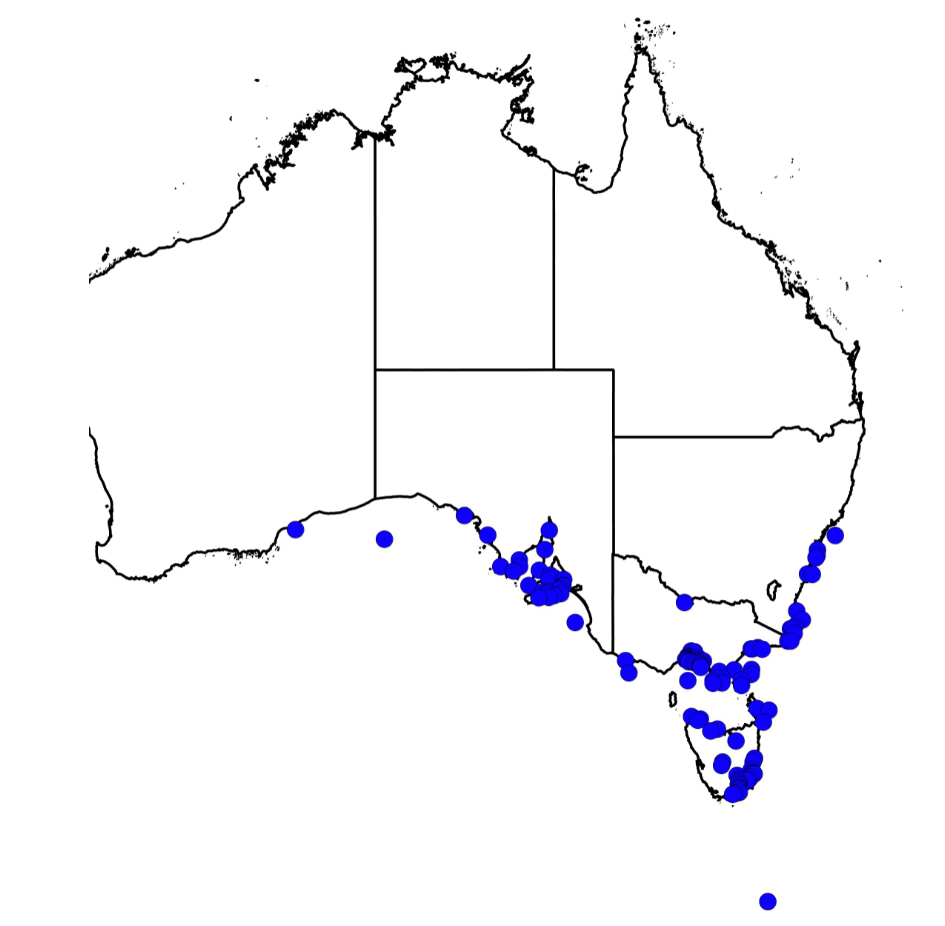Giant spider crab distribution and biology
![]() Giant spider crabs - Leptomithrax gaimardii – are the largest growing spider crabs in Victoria’s waters. They can reach 16 cm across their carapace or shell, and 70 cm across their legs – although most are not this big. Giant spider crabs are scavengers, eating a range of different types of food on or near the seafloor. They are usually orange to red-brown in colour, and can have seaweed, sponges or sea squirts attached to their body.
Giant spider crabs - Leptomithrax gaimardii – are the largest growing spider crabs in Victoria’s waters. They can reach 16 cm across their carapace or shell, and 70 cm across their legs – although most are not this big. Giant spider crabs are scavengers, eating a range of different types of food on or near the seafloor. They are usually orange to red-brown in colour, and can have seaweed, sponges or sea squirts attached to their body.
Detailed keys are available to identify giant spider crabs. There is another common spider crab - ribbed spider crab or Leptomithrax sternocostulatus – which looks similar and lives in similar habitats but is more camouflaged and only grows to about a third the size. Ribbed spider crabs also have shorter walking legs which do not extend much longer than their carapace.
Where are they found?
 According to Australia’s national biodiversity database, giant spider crabs are widely distributed in south-eastern Australian marine waters. They are found in seaweed, reef and sand habitats.
According to Australia’s national biodiversity database, giant spider crabs are widely distributed in south-eastern Australian marine waters. They are found in seaweed, reef and sand habitats.
The Museum of Victoria describes giant spider crabs as common in shallow water but found down to 820m deep.
Conservation status
Giant spider crabs are a native species. They are not listed as of conservation concern in Victoria, nationally or internationally.
Life cycle
Like other crabs, giant spider crabs have a complicated life cycle. After mating, the female crab protects the fertilized eggs under her abdomen. The eggs hatch as tiny larvae (‘zoea’), which swim and grow in the plankton until they are ready to settle out on the seafloor as miniature crabs.
Crabs grow in stages. Each time, the crab needs to moult its old protective shell and expose a soft shell that hardens at its new, bigger size.
Aggregations
![]() Giant spider crabs gather in huge groups at certain shallow water locations during winter each year.
Giant spider crabs gather in huge groups at certain shallow water locations during winter each year.
This is an amazing natural phenomenon which has been celebrated in wildlife documentaries internationally and is becoming a feature of Victoria’s underwater calendar.
The aggregating crabs are thought to move in from deeper waters where they are usually more widely dispersed. Divers report clusters of crabs ‘on the move’ in Summer/ early Autumn, before they gather and settle for the mass winter aggregation. After the aggregation, the crabs are assumed to disperse back to deeper waters. Less is known about
our marine environment, and the behaviour of giant spider crabs, at these depths of the sea which are hard to explore by scuba.
Where, how and why do they aggregate?
Dense giant spider crab aggregations have been reported in a number of locations in Victoria’s nearshore waters, in Gippsland Lakes and further afield in Tasmania and South Australia. Aggregations seem to return to some shallow water areas year after year but can then for some reason move on.
Scientists currently believe that the aggregations are a way for giant spider crabs to find ‘safety in numbers’ during moulting, when the crabs’ soft shells make them more vulnerable to marine predators. An earlier theory that crabs are aggregating to breed has not been supported by diver observations so far.
Giant spider crabs at Blairgowrie and Rye
Recently there has been a regular giant spider crab aggregation in the area of Rye or Blairgowrie piers. This is one of, if not the only, local crab aggregations can be easily accessed by divers, snorkelers and recreational fishers – without requiring a boat. It has also provided a window to view and better understand the crabs behaviour.
Anecdotally, fishing pressure on giant spider crabs in Victoria is known to be spatially and temporally localised and is a recent development that is being monitored by the Victorian Fisheries Authority (VFA). The crabs are seasonally abundant at some locations, but their natural disaggregation and dispersal lends an additional level of resilience to their populations.
The Blairgowrie / Rye crab aggregation is a wonderful Victorian natural asset. It is valued and appreciated by different members of our community for different reasons. Mutual respect and understanding – alongside monitoring, management, education and enforcement – will continue to be critical to persistence and enjoyment of this natural phenomenon into the future.
To download this information click on the fact sheets
